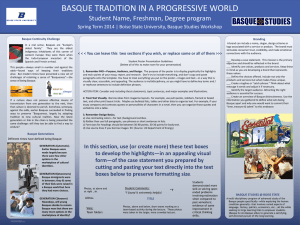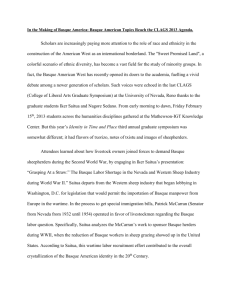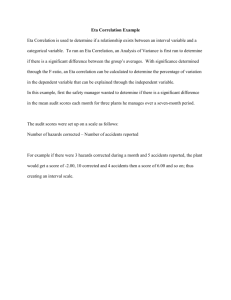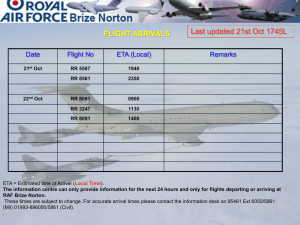Prosodic transcriptions in progress for EDAK corpus (Basque
advertisement
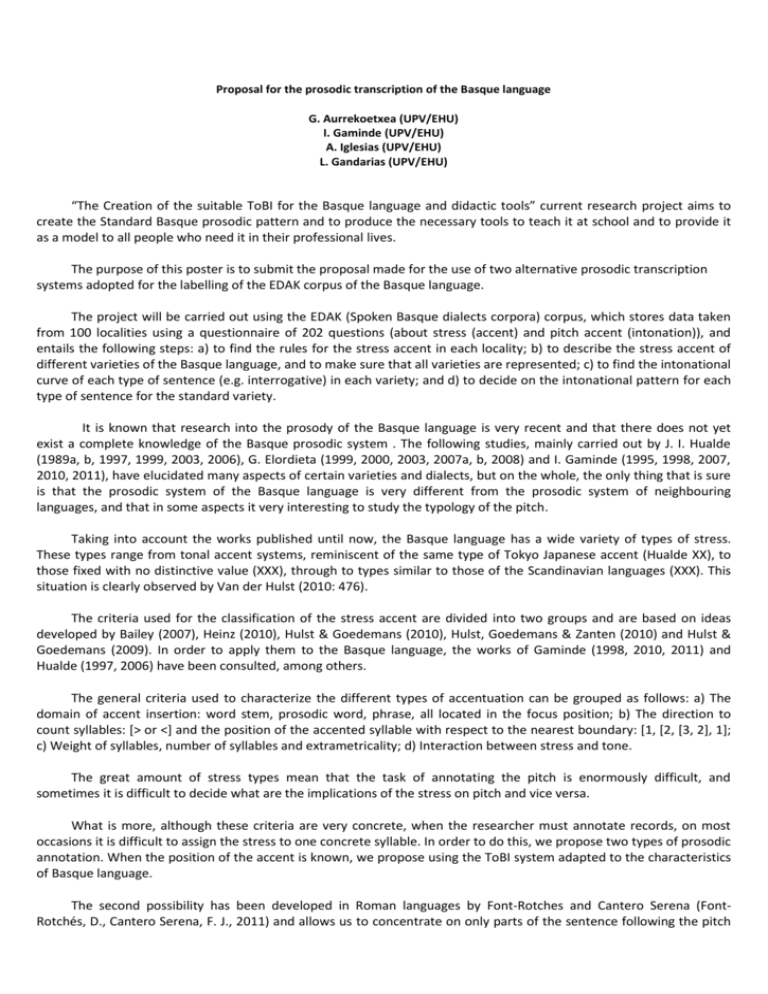
Proposal for the prosodic transcription of the Basque language G. Aurrekoetxea (UPV/EHU) I. Gaminde (UPV/EHU) A. Iglesias (UPV/EHU) L. Gandarias (UPV/EHU) “The Creation of the suitable ToBI for the Basque language and didactic tools” current research project aims to create the Standard Basque prosodic pattern and to produce the necessary tools to teach it at school and to provide it as a model to all people who need it in their professional lives. The purpose of this poster is to submit the proposal made for the use of two alternative prosodic transcription systems adopted for the labelling of the EDAK corpus of the Basque language. The project will be carried out using the EDAK (Spoken Basque dialects corpora) corpus, which stores data taken from 100 localities using a questionnaire of 202 questions (about stress (accent) and pitch accent (intonation)), and entails the following steps: a) to find the rules for the stress accent in each locality; b) to describe the stress accent of different varieties of the Basque language, and to make sure that all varieties are represented; c) to find the intonational curve of each type of sentence (e.g. interrogative) in each variety; and d) to decide on the intonational pattern for each type of sentence for the standard variety. It is known that research into the prosody of the Basque language is very recent and that there does not yet exist a complete knowledge of the Basque prosodic system . The following studies, mainly carried out by J. I. Hualde (1989a, b, 1997, 1999, 2003, 2006), G. Elordieta (1999, 2000, 2003, 2007a, b, 2008) and I. Gaminde (1995, 1998, 2007, 2010, 2011), have elucidated many aspects of certain varieties and dialects, but on the whole, the only thing that is sure is that the prosodic system of the Basque language is very different from the prosodic system of neighbouring languages, and that in some aspects it very interesting to study the typology of the pitch. Taking into account the works published until now, the Basque language has a wide variety of types of stress. These types range from tonal accent systems, reminiscent of the same type of Tokyo Japanese accent (Hualde XX), to those fixed with no distinctive value (XXX), through to types similar to those of the Scandinavian languages (XXX). This situation is clearly observed by Van der Hulst (2010: 476). The criteria used for the classification of the stress accent are divided into two groups and are based on ideas developed by Bailey (2007), Heinz (2010), Hulst & Goedemans (2010), Hulst, Goedemans & Zanten (2010) and Hulst & Goedemans (2009). In order to apply them to the Basque language, the works of Gaminde (1998, 2010, 2011) and Hualde (1997, 2006) have been consulted, among others. The general criteria used to characterize the different types of accentuation can be grouped as follows: a) The domain of accent insertion: word stem, prosodic word, phrase, all located in the focus position; b) The direction to count syllables: [> or <] and the position of the accented syllable with respect to the nearest boundary: [1, [2, [3, 2], 1]; c) Weight of syllables, number of syllables and extrametricality; d) Interaction between stress and tone. The great amount of stress types mean that the task of annotating the pitch is enormously difficult, and sometimes it is difficult to decide what are the implications of the stress on pitch and vice versa. What is more, although these criteria are very concrete, when the researcher must annotate records, on most occasions it is difficult to assign the stress to one concrete syllable. In order to do this, we propose two types of prosodic annotation. When the position of the accent is known, we propose using the ToBI system adapted to the characteristics of Basque language. The second possibility has been developed in Roman languages by Font-Rotches and Cantero Serena (FontRotchés, D., Cantero Serena, F. J., 2011) and allows us to concentrate on only parts of the sentence following the pitch curve. Furthermore, it allows us to avoid the different types of word accents when we are annotating pitch features of the sentence. References Bailey, T. M. (2007). The Stress System Database. http://www.cardiff.ac.uk/psych/subsites/ssdb/index.html Elordieta, G., (2008). “Euskal azentu eta intonazioari buruzko ikerketa: status quaestionis”. <http://www.elebilab.com/documentos/archivos/publicaciones/Elordieta-Koldo%20Mitxelena% 20Katedrarako.pdf> Elordieta, G., Gaminde, I., Hernáez, I., Salaberria, J. eta Martín de Vidales, I. (1999). “Another Step in the Modeling of Basque Intonation: Bermeo”, in V. Matousek, P. Mautner, J. Ocelíková & P. Sojka (eds.). Text, Speech and Dialogue. Plzeñ. Elordieta. G. (1999). “Primer estudio comparativo de la entonación de tres variedades dialectales vascas”, in Actas del I Congreso de Fonética Experimental. Barcelona: Universitat Rovira i Virgili and Universitat de Barcelona. Elordieta. G. (2000). “Mendebaldeko intonazioaren inguruan”, in Mendebalde Kultura Alkartea: Mendebaldeko berbetearen formalizazinoa. Bilbao: Mendebalde Kultur Elkartea. Elordieta. G. (2003). “Intonation”, in J.I. Hualde eta J. Ortiz de Urbina (arg.), A grammar of Basque, Berlin: Mouton de Gruyter. Elordieta. G. (2007a). “Constraints on intonational prominence of focalized constituents”, in D. Büring., M. Gordon eta C.L. Lee (eds.), Topic and focus: Papers from a workshop on intonation and meaning. Dordrecht: Springer. Elordieta. G. (2007b). “A constraint-based analysis of the intonational realization of focus in Northern Bizkaian Basque”, in T. Riad eta C. Gussenhoven (eds.), Tones and Tunes: Volume I, Typological Studies in Word and Sentence Prosody. Berlin: Mouton de Gruyter. Font-Rotchés, D., Cantero Serena, F. J. (2011). “Análisis contrastivo de la entonación de las interrogativas absolutas del castellano y del catalán”, paper presented to V Congreso de Fonética Experimental. Caceres 2011. Gaminde, I. (1995). Bizkaieraren azentu-moldeez. Bilbao: Labayru Ikastegia. Gaminde, I. (1998). Euskaldunen azentuak. Bilbao: Labayru Ikastegia. Gaminde, I. (2007). Bizkaian zehar. Euskararen ikuspegi orokorra. Bilbao: Mendebalde Kultura Alkartea. Gaminde, I. (2010). Bizkaiko gazteen prosodiaz: euskaraz eta gaztelaniaz. Bilbao: Mendebalde Kultura Alkartea eta BFA. Gaminde, I. (2011). “Noraka Euskal Azentuak?” in G. Aurrekoetxea, eta I. Gaminde (koor.), Prosodiaz eta Hezkuntzaz I. Jardunaldiak / I. Jornadas sobre Prosodia y Educación. Bilbao: UPV/EHU. Heinz, J. (2010). UD Phonology Lab Stress Pattern Database. http://phonology.cogsci.udel.edu/dbs/stress/ Hualde, J. I., Elordieta, G, Gaminde, I. & Smiljanic, R. (2002). “From pitch-accent to stress-accent in Basque”, in C. Gussenhoven eta N. Warner (eds.). Laboratory Phonology VII. Berlin: Mouton de Gruyter. Hualde, J.I. & Lujanbio, O. (2008), “Goizuetako azentuera”, in X. Artiagoitia & J.A. Lakarra (eds.). Gramatika jaietan. Patxi Goenagaren omenez. ASJU, gehigarriak, 51, Bilbao: UPV/EHU. Hualde, J.I. (1989a). “Acentos vizcaínos”, ASJU 23-1, . Hualde, J.I. (1989b). “Otro acento vizcaíno: Getxo”, ASJU 23-3, . Hualde, J.I. (1997). Euskararen azentuerak. ASJU, gehigarriak, 42. Bilbo / Donostia: EHU eta GFA. Hualde, J.I. (1999). “Basque accentuation”, in H. van der Hulst (ed.). Word prosodic systems in the languages of Europe. Berlin: Mouton de Gruyter. Hualde, J.I. (2003). “From phrase-final to post-initial accent in western Basque”, in P. Fikkert eta H. Jacobs (eds.), Development in prosodic systems. Berlin: Mouton de Gruyter. Hualde, J.I. (2006). “Estado actual de las investigaciones sobre la acentuación en lengua vasca”, Oihenart 21, . Hualde, J.I., Elordieta, G. & Elordieta, A. (1994). The Basque Dialect of Lekeitio. ASJU, gehigarriak, 34. Bilbao / Donostia: EHU eta GFA. Hualde, J.I., Lujanbio, O. eta Torreira, F. (2008). “Lexical tone and stress in Goizueta Basque”, Journal of the International Phonetic Association 38-1. Hulst van der, H. eta Goedemans, R. (2009). StressTyp: A Database for Word Accentual Patterns in the World's Languages, in M. Everaert, S. Musgrave eta A. Dimitriadis (eds.) The Use of Databases in Cross-Linguistics Studies. New York, Berlin: Mouton de Gruyter. Hulst van der, H., Goedemans, R. & Zanten van, E. (2010). “Word Accent: terms, typologies and theories”, in R. Goedemans, H. van der Hulst & E. van Zanten (eds.), Word accent structure in the languages of the world. Berlin: Mouton de Gruyter. Hulst van der, H., Goedemans, R. & Zanten van, E. (eds.) (2010). A Survey of Word Accentual Patterns in the Languages of the World. Berlin: Mouton de Gruyter. Hulst, H.G. van der & Goedemans, R. (2010). StressTyp. http://www.unileiden.net/stresstyp/
